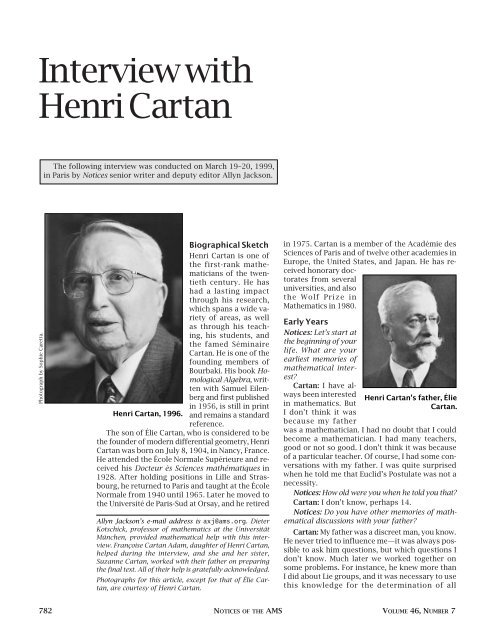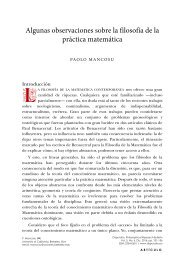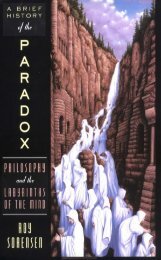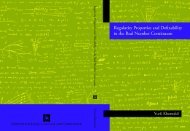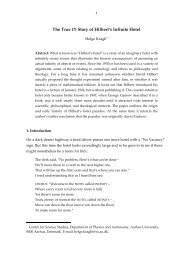fea-cartan
fea-cartan
fea-cartan
Create successful ePaper yourself
Turn your PDF publications into a flip-book with our unique Google optimized e-Paper software.
Interview with<br />
Henri Cartan<br />
The following interview was conducted on March 19–20, 1999,<br />
in Paris by Notices senior writer and deputy editor Allyn Jackson.<br />
Photograph by Sophie Caretta.<br />
Biographical Sketch<br />
Henri Cartan is one of<br />
the first-rank mathematicians<br />
of the twentieth<br />
century. He has<br />
had a lasting impact<br />
through his research,<br />
which spans a wide variety<br />
of areas, as well<br />
as through his teaching,<br />
his students, and<br />
the famed Séminaire<br />
Cartan. He is one of the<br />
founding members of<br />
Bourbaki. His book Homological<br />
Algebra, written<br />
with Samuel Eilenberg<br />
and first published<br />
in 1956, is still in print<br />
Henri Cartan, 1996. and remains a standard<br />
reference.<br />
The son of Élie Cartan, who is considered to be<br />
the founder of modern differential geometry, Henri<br />
Cartan was born on July 8, 1904, in Nancy, France.<br />
He attended the École Normale Supérieure and received<br />
his Docteur ès Sciences mathématiques in<br />
1928. After holding positions in Lille and Strasbourg,<br />
he returned to Paris and taught at the École<br />
Normale from 1940 until 1965. Later he moved to<br />
the Université de Paris-Sud at Orsay, and he retired<br />
Allyn Jackson’s e-mail address is axj@ams.org. Dieter<br />
Kotschick, professor of mathematics at the Universität<br />
München, provided mathematical help with this interview.<br />
Françoise Cartan Adam, daughter of Henri Cartan,<br />
helped during the interview, and she and her sister,<br />
Suzanne Cartan, worked with their father on preparing<br />
the final text. All of their help is gratefully acknowledged.<br />
Photographs for this article, except for that of Élie Cartan,<br />
are courtesy of Henri Cartan.<br />
in 1975. Cartan is a member of the Académie des<br />
Sciences of Paris and of twelve other academies in<br />
Europe, the United States, and Japan. He has received<br />
honorary doctorates<br />
from several<br />
universities, and also<br />
the Wolf Prize in<br />
Mathematics in 1980.<br />
Early Years<br />
Notices: Let’s start at<br />
the beginning of your<br />
life. What are your<br />
earliest memories of<br />
mathematical interest?<br />
Cartan: I have always<br />
been interested<br />
in mathematics. But<br />
I don’t think it was<br />
because my father<br />
Henri Cartan’s father, Élie<br />
Cartan.<br />
was a mathematician. I had no doubt that I could<br />
become a mathematician. I had many teachers,<br />
good or not so good. I don’t think it was because<br />
of a particular teacher. Of course, I had some conversations<br />
with my father. I was quite surprised<br />
when he told me that Euclid’s Postulate was not a<br />
necessity.<br />
Notices: How old were you when he told you that?<br />
Cartan: I don’t know, perhaps 14.<br />
Notices: Do you have other memories of mathematical<br />
discussions with your father?<br />
Cartan: My father was a discreet man, you know.<br />
He never tried to influence me—it was always possible<br />
to ask him questions, but which questions I<br />
don’t know. Much later we worked together on<br />
some problems. For instance, he knew more than<br />
I did about Lie groups, and it was necessary to use<br />
this knowledge for the determination of all<br />
782 NOTICES OF THE AMS VOLUME 46, NUMBER 7
ounded circled domains which admit a transitive<br />
group. So we wrote an article on the<br />
subject together [“Les transformations des<br />
domaines cerclés bornés”, C. R. Acad. Sci.<br />
Paris 192 (1931), 709–712]. But in general<br />
my father worked in his corner, and I<br />
worked in mine.<br />
Notices: You were interested<br />
in music.<br />
Cartan: Yes. I had a<br />
brother two years younger<br />
than myself, who became a<br />
composer. But he died at age<br />
25 of tuberculosis. It was a<br />
great loss. Of course I played<br />
much music, but I can’t now<br />
because I can’t see.<br />
Notices: What about your<br />
other siblings? Did you have<br />
other brothers?<br />
Cartan: Yes, a younger brother who became<br />
a physicist. But he was killed during the<br />
war by the Germans, because he was in the<br />
Résistance. He was deported to Germany<br />
in February 1943, sentenced<br />
to death in August, and beheaded<br />
in December of the same year. From<br />
February 1943 right until the end of<br />
May 1945, we never heard about<br />
him. Under the circumstances, one<br />
could not expect to get any news.<br />
Some German colleagues were so<br />
good as to try to find out about<br />
him, but they didn’t succeed.<br />
Notices: Who were the German colleagues?<br />
Cartan: One of them was Heinrich Behnke.<br />
Though a little older, Behnke was a friend of mine.<br />
My first invitation to go to Germany occurred in<br />
May 1931. Behnke was teaching in Münster-in-<br />
Westfalen, and he had a lot of students, about 40.<br />
I was invited because I had published a note in the<br />
Comptes Rendus de l’Académie des Sciences about<br />
circled domains [“Les transformations analytiques<br />
des domaines cerclés les uns dans les autres”, C.<br />
R. Acad. Sci. Paris 190 (1930), 718–720], where I<br />
had proved quite easily a theorem which had been<br />
proved earlier by Behnke, but under certain conditions,<br />
in a particular case. So I was invited to give<br />
several speeches in Münster. That was in 1931, and<br />
Behnke invited me again in 1937. It was the time<br />
of Hitler.<br />
Before the war, since November 1931, I had<br />
been teaching at the University of Strasbourg. But<br />
in September 1939, the inhabitants of Strasbourg<br />
had to be evacuated. The university was displaced<br />
to Clermont-Ferrand, where I taught for a year before<br />
I was appointed professor at the Sorbonne in<br />
Paris, in November 1940 (in fact, I was to be in<br />
Excerpts from the minutes by Jean Delsarte of the first<br />
preparatory meeting of the group that was later to become<br />
Bourbaki. These excerpts are taken from the only extant<br />
original copy of the minutes, in the possession of Henri Cartan.<br />
The nine people listed in the top excerpt were the members of<br />
the group. The first meeting was January 14, 1935. Later<br />
Dubreil and Leray dropped out, and the seven others became<br />
Bourbaki. The second and third excerpts give André Weil’s<br />
ideas concerning readership and style, and the fourth<br />
discusses assignments for the next meeting.<br />
charge of the mathematics students at the École<br />
Normale).<br />
Throughout the war I was not permitted to go<br />
to my apartment in Strasbourg. One day, Behnke<br />
AUGUST 1999 NOTICES OF THE AMS 783
Photograph by Jean Delsarte.<br />
The first Bourbaki congress, at Besse-en-Chandesse, July 1935. Left<br />
to right, standing: Henri Cartan, René de Possel, Jean Dieudonné,<br />
André Weil, and a university laboratory technician; seated: Mirlès<br />
(“guinea pig”), Claude Chevalley, and Szolem Mandelbrojt. The<br />
“guinea pig” was a person being considered for membership in<br />
Bourbaki.<br />
offered to try and retrieve some mathematical papers<br />
I had left there. He actually went to Strasbourg,<br />
but to no avail. He tried again and succeeded. He<br />
managed to get hold of some documents, which<br />
he left with the library of the University of Freiburg.<br />
In 1945, some members of the French Forces in Germany<br />
happened to find them there and returned<br />
them to me. Among those papers were the comptes<br />
rendus, minutes, of the first meetings of certain<br />
people who later became the Bourbaki group. That<br />
was the very beginning of Bourbaki’s work. I don’t<br />
think there exists another copy of these comptes<br />
rendus.<br />
I returned to the University of Strasbourg after<br />
the war, at the end of 1945, for two years. In November<br />
1946, I went to the Research Institute in<br />
Oberwolfach. It was very cold; there was snow and<br />
ice. I saw Professor Süß (the founder of Oberwolfach)<br />
and Frau Süß, and also Heinrich Behnke. I remember<br />
they asked me to play the piano. It was a<br />
beautiful piano—there were two pianos there. The<br />
old château at Oberwolfach doesn’t exist anymore.<br />
I visited Oberwolfach several times after that. I was<br />
very grateful to my German colleagues for what<br />
they had done during the war.<br />
Notices: Your relations with your German colleagues<br />
did not suffer at all during the war?<br />
Cartan: No—with certain German colleagues,<br />
not all of them.<br />
Notices: When you first went to visit Behnke,<br />
were there a lot of differences between the mathematical<br />
climates in France and in Germany?<br />
Cartan: It is difficult to answer the question,<br />
because it depends. Of course, there were not<br />
so many mathematicians in France who were<br />
interested in analytic functions of several complex<br />
variables.<br />
Notices: But there was a big tradition in<br />
France for function theory of one variable.<br />
Cartan: Yes. It was perhaps the thing which<br />
was studied in France by most mathematicians—my<br />
father’s work was an exception.<br />
Notices: But you were the one who started<br />
to work on several variables in France.<br />
Cartan: I believe it was André Weil who suggested<br />
that it could be interesting. He told me<br />
about the work of Carathéodory on circled domains.<br />
That was the beginning of my interest.<br />
Behnke’s assistant in 1931, namely Peter<br />
Thullen, was to become one of my best friends.<br />
We collaborated and wrote a paper together for<br />
the Mathematische Annalen [“Zur Theorie der<br />
Singularitäten der Funktionen mehrerer Komplexen<br />
Veränderlichen”, Math. Ann. 106 (1932),<br />
617–647]. I always had a good relationship<br />
with Thullen. At the beginning of 1933 or 1934,<br />
he left Germany—not because he was Jewish,<br />
he was Catholic, a deeply convinced Catholic.<br />
Thanks to Courant, he got a position in Ecuador.<br />
Thullen founded the Social Security system in<br />
Ecuador, and later in Colombia. In 1951, I think,<br />
he came back to Europe. I was very glad he did. He<br />
went to Geneva to work with the Bureau International<br />
du Travail (B.I.T.), where he was in charge<br />
of Social Security systems in Latin America. When<br />
he retired from that position, he was appointed at<br />
the University of Zürich, thanks to Van der Waerden,<br />
and later he became professor of mathematics<br />
in Fribourg, Switzerland. I have always had a<br />
very good relationship with his eldest son, who<br />
worked with the United Nations in Geneva, and is<br />
now retired. He visits us every year.<br />
Notices: When did you go to the United States for<br />
the first time?<br />
Cartan: I went to the United States for the first<br />
time in 1948. In fact, during the war—I think it was<br />
in 1942—I was invited to the United States, because<br />
they wanted to protect French people from German<br />
aggression. But it was not possible for me to move<br />
there, because of my family, and because my father<br />
was getting old. I was invited by Harvard University<br />
to visit from the beginning of February till<br />
the end of May 1948. But prior to that I was invited<br />
to Chicago by André Weil in January. So before I<br />
left I had to learn some English, because in order<br />
to be able to give lectures in English, it was necessary<br />
for me to know some words! My first lectures<br />
I had to write out in English beforehand.<br />
Later I wrote only the résumés. When I arrived at<br />
the airport in New York in December 1947, I was<br />
met by Samuel Eilenberg. It was my first encounter<br />
784 NOTICES OF THE AMS VOLUME 46, NUMBER 7
with Sammy. Staying in the States was very important<br />
for me. I learned a lot.<br />
Münster, December 20, 1963. Front row, left to<br />
right: Heinrich Behnke and Henri Cartan.<br />
Beginnings of Bourbaki<br />
Notices: You first met André Weil when you were<br />
students together at the École Normale in Paris.<br />
Cartan: Yes. We were there together, but he had<br />
been admitted the year before, at age 16.<br />
Notices: You and Weil happened to be students<br />
at the École Normale together with such people as<br />
Jean Dieudonné, Claude Chevalley, Jean Delsarte,<br />
Jean Leray ….<br />
Cartan: Dieudonné of course came after me. I<br />
was no longer at the École Normale when Leray entered.<br />
He entered the same year as Chevalley.<br />
Notices: These were some of the people who<br />
went on to form Bourbaki. Was there something at<br />
the École Normale, or in your common background,<br />
that later made you form Bourbaki?<br />
Cartan: You see, after the First World War, there<br />
were not so many scientists, I mean good scientists,<br />
in France, because most of them had been killed.<br />
We were the first generation after the war. Before<br />
us there was a vide, a vacuum, and it was necessary<br />
to make everything new. Some of my friends<br />
went abroad, notably to Germany, and observed<br />
what was being done there. This was the beginning<br />
of a mathematical renouveau, renewal. It was due<br />
to such people as Weil, Chevalley, de Possel …. The<br />
same people, responding to André Weil’s initiative,<br />
came together to form the Bourbaki group. In Bourbaki<br />
I learned very much. Almost all I know in<br />
mathematics I learned from and with the Bourbaki<br />
group.<br />
Notices: Leray was not in Bourbaki.<br />
Cartan: Not quite. In fact, Leray was in the first<br />
group, at the beginning: a group which met from<br />
January to June, 1935. At that time we were considering<br />
writing a Traité d’Analyse. But two out of<br />
the group left before the summer; they didn’t wish<br />
to continue. Leray was one of them. The final group<br />
was fixed in July 1935, in the so-called Congrès de<br />
Besse-en-Chandesse, and this group made decisions<br />
as to what they were going to treat.<br />
Notices: It was the comptes rendus of these<br />
meetings in the first half of 1935 that were left in<br />
Strasbourg in your apartment?<br />
Cartan: Yes.<br />
Notices: Who wrote the comptes rendus?<br />
Cartan: They were always written by Delsarte.<br />
Because of his position in the University of Nancy,<br />
he could have them typed by his secretary. Of<br />
course, typing was not so easy as it is now.<br />
Notices: In those early meetings, was there a certain<br />
person who was dominant in the group?<br />
Cartan: My answer is “André Weil”, but you see,<br />
in Bourbaki most members had strong personalities.<br />
We often disagreed, we often had big arguments—but<br />
we remained good friends. For each<br />
subject, a “rédacteur” was appointed. Later, his rédaction<br />
was read aloud and thoroughly examined.<br />
The next “rédacteur” was given the appropriate instructions,<br />
and so on. For each chapter there could<br />
be up to nine rédactions. But in the end, everybody<br />
was fatigué—tired. And Dieudonné would say, “It<br />
is finished now. I shall write the last rédaction.”<br />
Which he did. And eventually, although it seemed<br />
to be impossible to reach a complete agreement,<br />
there was an agreement. But it took time. It is perhaps<br />
not the best way in terms of teamwork, but<br />
that was the way we took.<br />
Notices: Do you think that the Bourbaki style is<br />
dominant in France now?<br />
Cartan: I don’t think so. You see, it’s a way of<br />
presenting some mathematical theories, but it<br />
does not claim to be the only way of doing mathematics.<br />
And each member of Bourbaki actually did<br />
things on his own and in his own way. When I<br />
wrote papers, I was not making rédactions for<br />
Bourbaki.<br />
Notices: And yet, Bourbaki had an enormous<br />
influence on French mathematics.<br />
Cartan: Not only in France. Outside France also,<br />
certain great mathematicians were influenced. For<br />
instance, Sir Michael Atiyah did some very beautiful<br />
mathematics, and being familiar with the<br />
Bourbaki way of thinking certainly helped him.<br />
Today, things are completely different. I don’t<br />
think Bourbaki has a big influence on today’s mathematicians.<br />
But it was certainly of great importance<br />
in the development of mathematics over<br />
several decades.<br />
Notices: So you are saying the influence of Bourbaki<br />
now is not as strong as it used to be.<br />
Cartan: What Bourbaki had to do is done now.<br />
Bourbaki is not eternal. But there still is the Séminaire<br />
Bourbaki, organized by some present members<br />
of Bourbaki. It is difficult for me to judge its<br />
influence, because I cannot have a good look at the<br />
mathematics of today.<br />
Notices: Your work stretches over many parts of<br />
mathematics. It is quite unusual, because nowadays<br />
people are much more specialized. You seem<br />
AUGUST 1999 NOTICES OF THE AMS 785
Cartan speaking at a colloquium in honor of the 60th birthday of Karl<br />
Stein, Munich, January 12, 1973.<br />
to have covered most of pure mathematics, or<br />
touched upon all the areas.<br />
Cartan: I can’t agree with this statement. I was<br />
interested in several fields, for instance, homological<br />
algebra, because of Eilenberg. We discovered<br />
together the generality of this notion. In fact, we<br />
had to find a title for our book, so we said: “It is<br />
algebra, but it is homological algebra. So we will<br />
call the book Homological Algebra.” What is surprising<br />
is that this book is still printed and sold<br />
today. I think it is quite remarkable, because it is<br />
now 43 years since the book first appeared. All of<br />
it was written by Sammy—I say “Sammy” because<br />
that’s the way everybody called him. Sammy wrote<br />
everything; I wrote nothing. Of course, we had discussions,<br />
but after that Sammy wrote. And I was<br />
in charge of correcting the spelling mistakes—in<br />
English! I don’t know much English, but I can spell.<br />
It was very easy and pleasant to work and discuss<br />
with Sammy.<br />
Teaching at the École Normale and<br />
Learning There and Elsewhere<br />
Notices: How did you choose problems to work on?<br />
Cartan: They just came. Some people got me interested<br />
in some questions, for instance, Marcel<br />
Brelot. He was a great specialist in potential theory.<br />
He posed me some questions and problems,<br />
and I could solve them. It was during the war.<br />
After the war, when I began to give my Séminaire<br />
at the École Normale, Jean-Pierre Serre asked me<br />
very many questions. He helped me discover many<br />
things by his questions. It was very important for<br />
me to know Serre and to hear his questions. When<br />
he prepared his thesis, he kept asking me questions,<br />
so I was forced to think about them. I learned<br />
a lot from my students at the École Normale. Many<br />
of them prepared theses under my direction—one<br />
normally says “direction”, but my “direction”<br />
consisted in understanding what they<br />
had in mind. So I learned very much. I was<br />
able to collaborate with Godement, for instance,<br />
who was one of my students at the<br />
École Normale. He entered the École Normale<br />
in 1940, when I began to teach there.<br />
In that promotion, there was Godement<br />
and there was Koszul, who later prepared<br />
his thesis “under my direction”. But he<br />
knew what he wanted to do. The students<br />
had to be helped of course, but they had<br />
their own ideas. Each one has his own personality,<br />
and you have to respect this personality,<br />
to help him find his own personality,<br />
and certainly not to impose<br />
somebody else’s ideas.<br />
When I taught the first-year students,<br />
they had to solve some problems at home,<br />
and I corrected them. But they would also<br />
come to the blackboard, and I would help<br />
them discover various mathematical theories.<br />
Notices: So this was a very individual teaching;<br />
you had students one on one.<br />
Cartan: Yes, so it was possible to see what the<br />
students were able to understand. For the second<br />
year, I gave a regular course on a subject which<br />
changed every year. For the third year, there was<br />
the Agrégation. The students had to give lectures<br />
and to be criticized by the others—and by myself,<br />
of course. The fourth-year students had to choose<br />
a field of research. I had some discussions with<br />
each of them. In the first year, there were about<br />
twenty students. But in the second year, there were<br />
not so many, because some chose mathematics<br />
while others chose physics, so there were ten or<br />
twelve, and the same number for the third year.<br />
Notices: Were there differences between the way<br />
you were taught as a student at the École Normale,<br />
and the way you taught when you were a professor<br />
there?<br />
Cartan: Oh, yes. It was necessary to change that<br />
way of teaching. I did change it.<br />
Notices: Was there one among your professors<br />
whose style you found particularly agreeable?<br />
Cartan: I liked some professors, yes, of course.<br />
Gaston Julia for one, or my father, who gave some<br />
lessons at the École Normale, so I was his student.<br />
The students at the École Normale also had to attend<br />
general courses at the Sorbonne.<br />
Notices: What about your Séminaire? How was<br />
that related to your teaching?<br />
Cartan: I wanted to get several of my fourth-year<br />
students interested in some fields, notably in topology.<br />
Very soon Jean-Pierre Serre said, “But you<br />
must write down the exposés.” So, I wrote down the<br />
exposés, or I sometimes asked some of the others<br />
to write them down. At the beginning I had no precise<br />
long-term plans, but somehow this turned out<br />
786 NOTICES OF THE AMS VOLUME 46, NUMBER 7
to be an irreversible process, hence the<br />
Séminaire. Every year more and more<br />
people kept coming—not only students,<br />
but also mathematicians from France<br />
and abroad. Of course, there was no<br />
other Séminaire at the time. I typed the<br />
exposés myself, but later on, the job<br />
was done by the secretary of the Institut<br />
Henri Poincaré. And then, one thing<br />
leading to another, it even happened<br />
that for some parts of the Séminaire, I<br />
didn’t do a thing—for instance, when<br />
Grothendieck spent half a year explaining<br />
and developing his ideas.<br />
Notices: What are your memories of<br />
Grothendieck?<br />
Cartan: He is an exceptional man, of<br />
course. He had a great influence on<br />
some parts of mathematics, notably algebraic<br />
geometry. His approach was<br />
something new—though not completely<br />
new, because at the beginning, for instance,<br />
he himself was influenced by<br />
Serre. Grothendieck is a very special<br />
man. Nobody knows where he is or what<br />
he is doing now.<br />
Notices: Who is the mathematician you admire<br />
most?<br />
Cartan: I admired quite a few when I could do<br />
and understand mathematics. Today …!<br />
Notices: When you could do it, who was the person<br />
you admired most?<br />
Cartan: No, I don’t wish to answer the question.<br />
I admire many mathematicians, but I don’t wish to<br />
award prizes.<br />
Notices: What do you consider your most important<br />
achievement in mathematics?<br />
Cartan: It is for other people to say that.<br />
Notices: But maybe there is something you particularly<br />
liked, or something that was especially<br />
satisfying.<br />
Cartan: The connection between algebraic topology<br />
and analytic functions. I discovered general theorems<br />
which play a big role. But in this I was<br />
helped by Serre. By the way, this is one example<br />
of a mathematician for whom I have complete admiration:<br />
Serre.<br />
Notices: You have worked in many areas of<br />
mathematics. Do you feel equally at home in analysis,<br />
in algebra, in geometry …?<br />
Cartan: Geometry—not exactly geometry. Topology,<br />
I would say. But I could also see the relations<br />
between them. One day I discovered that topological<br />
notions, and in particular sheaf theory,<br />
could be applied to analytic functions of several<br />
variables. This was very important. One can use results<br />
from topology in order to get some important<br />
results for analytic functions. I think that is<br />
interesting.<br />
Photo: Gerd Fischer.<br />
Cartan at Oberwolfach in<br />
September 1971 (above) and<br />
October 5, 1984 (left).<br />
Notices: You have always worked in pure mathematics,<br />
and today applied mathematics is very<br />
important. What do you think of this?<br />
Cartan: You see, which parts of mathematics are<br />
applicable—not applied but applicable—it is very<br />
hard to tell in advance. When I was invited to Münster<br />
for the first time in 1931, they gave a big dinner<br />
at the end of my stay, and there was a big discussion.<br />
There was a philosopher who spoke about<br />
which parts of mathematics can be applied. “Anyway,”<br />
somebody said, “not analytic functions of several<br />
complex variables! That can’t be applied.” But<br />
it was actually applied later. So it is difficult to tell<br />
in advance. And why mathematics can be applied<br />
to other things, to physics—that’s a mystery.<br />
Politics and Human Rights<br />
Notices: You have been active in politics. Can you<br />
say something about that?<br />
Cartan: This is not mathematics!<br />
Notices: It has no relationship to mathematics?<br />
Cartan: Maybe it has …. You see, a mathematician<br />
thinks: “What is this question? What happens<br />
exactly? Why is it so, and not so? What is the reason?<br />
What is the logical consequence of all this?”<br />
I am applying this to politics. I have tried to analyze<br />
situations and to draw logical consequences.<br />
This was the way I became a European Federalist,<br />
because I understood that there is no other way.<br />
For me, what is going on now, today, proves the<br />
necessity of Federalism—if the word Federalism is<br />
correctly understood, that is. Some people misunderstand<br />
the word. In France, everything is decided<br />
at the top; nobody—except the Government—<br />
is responsible for anything. Look at what is going<br />
Photograph by Klaus Peters.<br />
AUGUST 1999 NOTICES OF THE AMS 787
Photographs by Sophie Caretta.<br />
Cartan at his desk (above) and with Madame Cartan,<br />
1996.<br />
on today in Kosovo. You hear people say, “Ah, Europe<br />
must have a common foreign policy.” Those<br />
are empty words: how can this ever be achieved<br />
without an authority that can make decisions and<br />
implement them and that can also be under democratic<br />
control? Nothing can ever be achieved unless<br />
a European constitution gives birth to a federal<br />
authority and makes it fully responsible for<br />
clearly defined areas of common interest. Of<br />
course, this federal authority would in no way encroach<br />
on the respective spheres of responsibility<br />
of either the states, regions, or townships.<br />
All this I believe only because I am a mathematician<br />
who thinks about the situation and the<br />
logical consequences of this situation.<br />
Notices: Would you agree that having lived in<br />
Strasbourg and gone through your experiences in<br />
the war may have influenced you in these views?<br />
Cartan: Yes, but I was not a Federalist at the end<br />
of the Second World War. I became a Federalist a<br />
few years later.<br />
Talking about the European elections—the first<br />
one was in 1979. It was very difficult to obtain these<br />
elections. The European Parliament did not have<br />
much power. After those elections I went to Strasbourg<br />
for each session of the European Parliament.<br />
Five years later, for the second election in<br />
1984, I was a candidate (in France, of course). In<br />
fact, I was at the head of a list. We didn’t have a<br />
party. Our list was called “Pour les États-Unis d’Europe”.<br />
Unfortunately, when it came to choosing a<br />
voting system for the European elections, the<br />
French Parliament decided in favor of choosing<br />
members out of national lists so that the French<br />
members of the European Parliament are chosen<br />
by political parties instead of grass-roots voters.<br />
Besides, one should not overlook the fact that<br />
such campaigns cost a tremendous amount of<br />
money, so that only the constituted parties (which<br />
are officially subsidized by the State) can afford<br />
them.<br />
Notices: You received an award from the New<br />
York Academy of Sciences, the Pagels Award. What<br />
was the award for?<br />
Cartan: This was for assisting dissidents. I was<br />
involved in the defense of dissidents in the USSR<br />
and other countries, especially mathematicians.<br />
The so-called Comité des Mathématiciens was created<br />
to defend dissidents. I was very active in this<br />
defense process. The most famous dissident mathematician<br />
at the time was Leonid Plyushch. There<br />
was a big to-do! Plyushch was in a “special” psychiatric<br />
hospital. This was back in 1973, and our<br />
attention had been called on his case by Andrei<br />
Sakharov. We began to call upon the Soviet Embassy<br />
in Paris—it was possible at the time, but it soon<br />
became impossible. When the International Congress<br />
of Mathematicians was held in Vancouver in<br />
1974, we tried to stir up the participants about the<br />
case of Plyushch. We asked people to sign an appeal,<br />
and gathered a thousand signatures asking<br />
for his liberation. I was asked to send a telegram<br />
to the Soviet authorities. As a consequence, when<br />
we returned to Paris, we organized this Comité<br />
des Mathématiciens, and we had several meetings<br />
at the seat of the Human Rights League in Paris.<br />
We held a big meeting in the Salle de Mutualité with<br />
several thousand people. Eventually, the Soviet<br />
authorities decided to free Plyushch in January<br />
1976. It was a big success.<br />
Later on, we worked for other people. The<br />
Uruguayan mathematician José Luís Massera, who<br />
was a Communist, was a victim of the military dictatorship<br />
there. The Comité des Mathématiciens—<br />
with such people as Laurent Schwartz—worked<br />
on his case. Today we have a very active Comité<br />
de Défense des Hommes de Science (CODHOS)<br />
within the French Académie des Sciences. Its president<br />
is François Jacob, a Nobel Prize laureate in<br />
medicine. Similar committees in France, Sweden,<br />
Great Britain, Italy, and the United States are now<br />
connected together and work hand in hand for<br />
similar purposes.<br />
788 NOTICES OF THE AMS VOLUME 46, NUMBER 7


